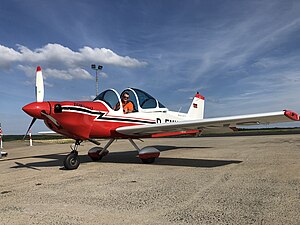Mylius My 102 Tornado
| My 102 Tornado | |
|---|---|

| |
| The first prototype | |
| Role | Sporting and aerobatic aircraft |
| National origin | Germany |
| First flight | 7 July 1973 |
| Number built | 2 |
The Mylius My 102 Tornado is a prototype single-seat German aerobatic aircraft. It was designed as a smaller derivative of the MBB Bo 209, but was not placed in production, with only two aircraft built.
Design and development
[edit]The German light aircraft manufacturer Bölkow's technical director Dr Hermann Mylius, together with two other engineers from the company, designed the two-seat MHK-101 in their spare time, with the design being adopted by Bölkow as the Bo 209, entering production in 1970.[1][2] As a follow-on to the Bo-209, Mylius began design work in July 1971 on a smaller, single-seat derivative of the Bo-209, intended as an aerobatic aircraft, the Mylius My 102 Tornado.[3][4] The My 102 was considered for production by Messerschmitt-Bölkow-Blohm (MBB),[3] the former Bölkow,[5] as the Bo 210 Tornado,[a] but instead, MBB abandoned production of light aircraft in order to concentrate on the Bo 105 helicopter.[7]
The My 102 is a low-wing cantilever monoplane of all-metal construction, powered by a 200 hp (150 kW) Lycoming AIO-360-B1B flat-four piston engine driving a three-bladed propeller.[8] It has a tricycle undercarriage with fixed mainwheels and a nosewheel which was retractable in the prototype with a plan to offer a fixed nosewheel as an option. The pilot sits in an enclosed cockpit, with a rearward sliding canopy. The aircraft's wings can be folded to minimise hangar space needed to store the aircraft or for towing on roads.[8]

Work began on construction of a prototype in December 1971, and it first flew, with the registration D-EMYS, on 7 July 1973 at Neubiberg.[3][4] It was successful in aerobatic competitions,[9] taking part in the 1973 German Aerobatic Championships and the 1974 Biancotto Trophy.[4] By 1980, a second prototype was under construction, with changes including a more powerful (225 hp (168 kW)) engine, revised wings with reduced span (7.89 m (25 ft 11 in)) and wing area (9.40 m2 (101.2 sq ft)).[10] Two derivatives of the My 102 were noted as being under development in the 1980 Jane's All the World's Aircraft, the two-seat My 103 Mistral (eventually to fly in 1998[11][12]) and the four-seat My 104 Passat.[9]
The second prototype, registration D-EMYM, flew for the first time on 3 April 1984.[3] The Tornado (now styled MY-102) was being proposed for production by Mylius Flugzeugwerk of Bitburg in 1999, and was claimed to conform to European Joint Aviation Authorities airworthiness standards.[13] Mylius was concentrating on the MY-103 by 2003, however.[12]
Specifications (First prototype)
[edit]
Data from Jane's All the World's Aircraft 1975–76[8]
General characteristics
- Crew: 1
- Length: 6.40 m (21 ft 0 in)
- Wingspan: 8.10 m (26 ft 7 in)
- Height: 2.31 m (7 ft 7 in)
- Wing area: 9.80 m2 (105.5 sq ft)
- Aspect ratio: 6.7:1
- Airfoil: NACA 64215 at root, NACA 64212 at tip
- Empty weight: 530 kg (1,168 lb)
- Max takeoff weight: 820 kg (1,808 lb)
- Fuel capacity: 146.8 L (38.8 US gal; 32.3 imp gal)
- Powerplant: 1 × Lycoming AIO-360-B1B air-cooled flat-four engine, 150 kW (200 hp)
- Propellers: 3-bladed Hoffmann HO-V 123/180R metal constant-speed propeller, 1.80 m (5 ft 11 in) diameter
Performance
- Maximum speed: 322 km/h (200 mph, 174 kn)
- Cruise speed: 296 km/h (184 mph, 160 kn)
- Stall speed: 97 km/h (60 mph, 52 kn) (flaps down)
- Never exceed speed: 396 km/h (246 mph, 214 kn)
- Range: 960 km (600 mi, 520 nmi)
- Service ceiling: 9,100 m (30,000 ft)
- Rate of climb: 12 m/s (2,400 ft/min)
References
[edit]- ^ The 1971 edition of Jane's All the World's Aircraft described the proposed Bo 210 as a two seat aircraft with fully retractable landing gear, and also mentioned a four-seat Bo 211 Taifun based on the Bo 210.[6]
- ^ Archive 1991 No. 2, p. 46.
- ^ Taylor 1968, pp. 80–81.
- ^ a b c d Archive 1991 No. 3, p. 76.
- ^ a b c Taylor 1975, p. 94.
- ^ Taylor 1971, p. 88.
- ^ Taylor 1971, p. 89.
- ^ Archive 1991 No. 3, pp. 75–76.
- ^ a b c Taylor 1975, pp. 94–95.
- ^ a b Taylor 1980, p. 84.
- ^ Taylor 1980, pp. 84–85.
- ^ Taylor 1999, p. 429.
- ^ a b Jackson 2003, p. 171.
- ^ Taylor 1999, pp. 429–430.
- "Aircraft of European Civil Registers : 6: The Bölkow Lightplanes: Part Six". Archive. No. 2. Air-Britain. 1991. pp. 45–48. ISSN 0262-4923.
- "Aircraft of European Civil Registers : 6: The Bölkow Lightplanes: Part Seven". Archive. No. 3. Air-Britain. 1991. pp. 73–76. ISSN 0262-4923.
- Jackson, Paul, ed. (2003). Jane's All the World's Aircraft 2003–2004. Coulsdon, UK: Jane's Information Group. ISBN 0-7106-2537-5.
- Taylor, John W. R., ed. (1968). Jane's All The World's Aircraft 1968-69. London: Sampson Low, Marston & Company, Ltd.
- Taylor, John W. R., ed. (1971). Jane's All The World's Aircraft 1971-72. London: Jane's Yearbooks. ISBN 0-354-00094-2.
- Taylor, John W. R., ed. (1975). Jane's All the World's Aircraft 1975–76. London: Jane's Yearbooks. ISBN 0-354-00521-9.
- Taylor, John W. R., ed. (1980). Jane's All the World's Aircraft 1980–81. London: Jane's Publishing Company. ISBN 0-7106-0705-9.
- Taylor, Michael J. H., ed. (1999). Brassey's World Aircraft & Systems Directory: 1999/2000. London: Brassey's. ISBN 1-85753-245-7.
